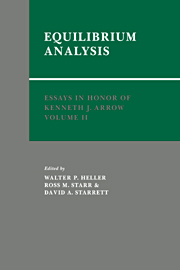Book contents
- Frontmatter
- Contents of Volumes I, II, III
- List of contributors
- Editors' preface
- Kenneth J. Arrow
- Contents
- PART I GENERAL EQUILIBRIUM
- 1 A general equilibrium theory of North–South trade
- 2 Soldiers of fortune?
- 3 The dynamics of industrywide learning
- 4 Decentralized trade in a credit economy
- 5 Lump-sum taxes and transfers: public debt in the overlapping-generations model
- 6 Coordination failure under complete markets with applications to effective demand
- PART II MICROFOUNDATIONS OF MACROECONOMICS
- Author index
1 - A general equilibrium theory of North–South trade
Published online by Cambridge University Press: 25 October 2011
- Frontmatter
- Contents of Volumes I, II, III
- List of contributors
- Editors' preface
- Kenneth J. Arrow
- Contents
- PART I GENERAL EQUILIBRIUM
- 1 A general equilibrium theory of North–South trade
- 2 Soldiers of fortune?
- 3 The dynamics of industrywide learning
- 4 Decentralized trade in a credit economy
- 5 Lump-sum taxes and transfers: public debt in the overlapping-generations model
- 6 Coordination failure under complete markets with applications to effective demand
- PART II MICROFOUNDATIONS OF MACROECONOMICS
- Author index
Summary
This chapter presents an application of competitive general equilibrium theory of markets in the spirit of Walras, formalized in the 1950s by K. Arrow and by G. Debreu. In using general equilibrium theory to generate insights into current policy issues, it follows a tradition established by Arrow in his work on welfare economics of medical care (1963), on the organization of economic activity (1969), on the evaluation of public investment (Arrow and Lind, 1970), and in urban economic development (1970).
The intention is to use formalized general equilibrium theory to derive general statements about the economic behavior and interrelations between two groups of countries: industrial and developing countries. The first group is represented by a cluster of competitive market economies called the North, and the second by a similar cluster of competitive economies called the South: thus the name North–South trade. The goal is to obtain simple and general results, and for this purpose we consider a stylized model with the minimum of characteristics needed for the task: two regions, two produced goods, and two factors of production. Within this simple model, we explore issues of current import, such as export-led policies and the transmission of economic activity between regions. The underlying theme is that general equilibrium analysis is indeed useful for disclosing patterns of economic behavior and for suggesting policies, a point of view that guided classical international economics.
- Type
- Chapter
- Information
- Essays in Honor of Kenneth J. Arrow , pp. 3 - 56Publisher: Cambridge University PressPrint publication year: 1986
- 8
- Cited by



